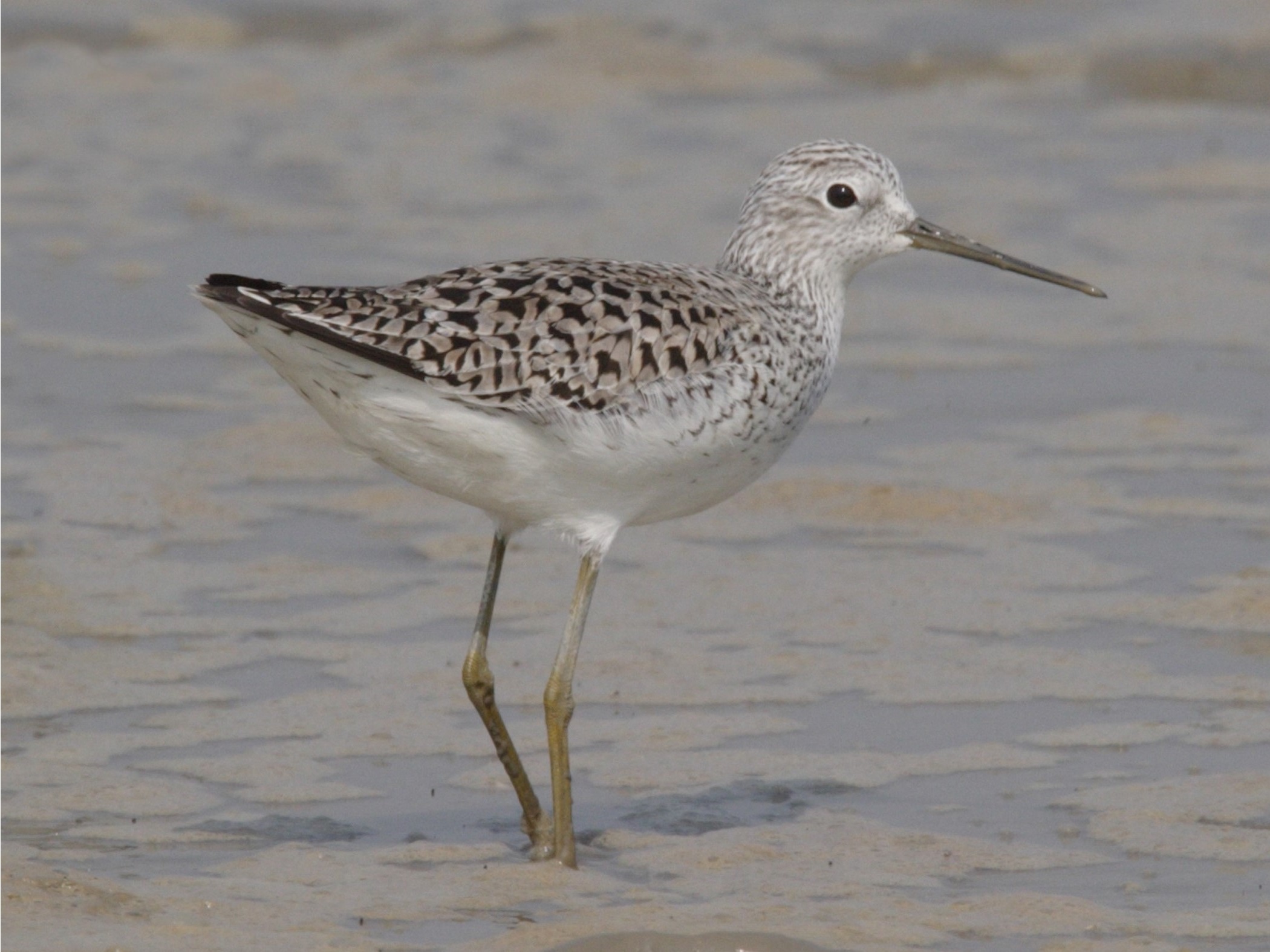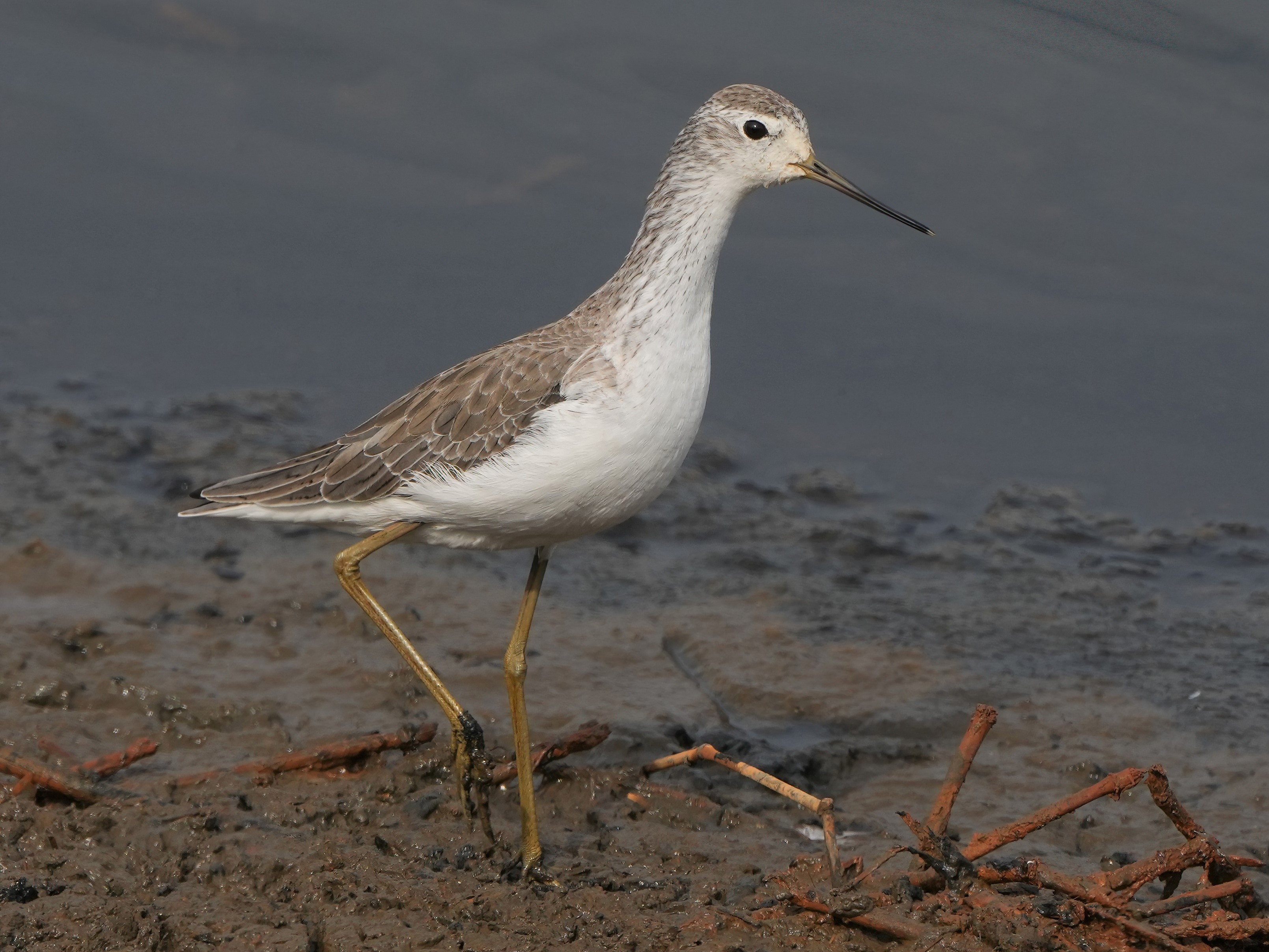Marsh Sandpiper Tringa stagnatilis 澤鷸
Category I. Scarce passage migrant, slightly more numerous in spring, and rare summer visitor; much declined. Occurs in vegetated freshwater wetlands.
IDENTIFICATION

Apr. 2004, John and Jemi Holmes. Adult, breeding plumage.
22-26 cm. Slightly larger in body size than Wood Sandpiper, though a lot more elegant with slim body, longer legs that project well-beyond the tail and longer, finer bill; plumage most resembles Common Greenshank but structure differs markedly.
Adult in breeding plumage rather brownish grey above with extensive blackish marks.

Nov. 2023, Paul Leader. Adult, non-breeding plumage.
In winter plumage rather plain grey or brownish-grey above. Face generally rather white and supercilium extends behind eye, though rather diffusely, highlighting the darker crown (c.f. Common Greenshank).

Aug. 2021, Sarawak, Malaysia. Dave Bakewell. Juvenile.
Juvenile has brown upperparts with clear-cut fairly broad pale fringes, notched greater coverts and tertials and white underparts.

Mar. 2022, Sarawak, Malaysia. Dave Bakewell. Adult moulting into breeding plumage.
In flight the white up the back nearly reaches the leading edge of the wing and feet project substantially behind the tail, which is barred more darkly than Common Greenshank.
VOCALISATIONS
The typical call is a sharp ‘tyoo’ that falls steeply in pitch and is reminiscent of Common Redshank.
The call of agitation or alarm, often when flushed, is usually a series of notes.
DISTRIBUTION & HABITAT PREFERENCE
The majority of records are from the intertidal mudflats of Deep Bay and adjacent roosting areas, primarily Mai Po NR. Elsewhere, occurs mainly at the freshwater wetland of Long Valley where up to nine are recorded annually, although up to 25 were noted historically. Frequently recorded in small numbers in commercial fish pond areas such as San Tin. Previously recorded at Shuen Wan, where up three birds were noted in spring and autumn, but not noted there since 2002. On Lantau up to three have been recorded, mainly at Shui Hau. Also recorded rarely at Kam Tin, Lam Tsuen, Luk Keng, Sha Tin, Sai Kung, Castle Peak, Po Toi (including a count of 15) and the former airport at Kai Tak.
OCCURRENCE
Marsh Sandpiper is generally obvious from late August to early May, with highest numbers on passage (Figure 1).
Autumn migrants are present from the second week of August, if not earlier. Subsequently, a gradual increase in numbers occurs with peak passage during the second half of October; the highest counts are 2,521 on 30 September and 16 October 2008. Numbers fall quite sharply from the first week of November.
The peak winter count on the HK side of Deep Bay is 2,249 on 7 December 2003, while the highest midwinter count for the whole of Deep Bay is 2,884 on 16 January 2011. The period from winter 2002/03 to winter 2011/12 saw relatively high numbers of Marsh Sandpiper wintering in Deep Bay (Figure 2), but since then numbers have returned to levels of the 1990s with usually 700-1,000 birds present.
Spring migration is certainly under way by the second week of March, but it seems that, as with the other large waders Tringa, passage may commence in late winter. The main passage period is from the middle of March to the third week of April, with the highest count being 3,192 on 10 April 2009. This species is notable for the sharp decrease in numbers that occurs after the third week of April.
Figure 3 illustrates peak spring and autumn counts from systematic shorebird surveys since 1998. In both seasons peak counts increased to a peak from autumn 2008 to spring 2011; this was followed by a fairly steep decrease to a lower level that lasted to autumn 2016, after which there was another fall until now. This pattern is similar to that in winter, suggesting there may be substantial overlap of birds present. The highest midsummer count is 29, though in most years only single figures are present.
First reported by Walker (1958) who had one on 8 May 1956. Macfarlane and Macdonald (1966) stated that it occurred in small numbers in spring from 9 February to 27 May and in groups of up to 30 between 22 August and 18 December.
BEHAVIOUR, FORAGING & DIET
Usually walks through shallow water picking items from the water surface. Groups of birds may also forage together dashing through the water with bill tip below the surface.
Forms large flocks at roost, either on the intertidal mudflat or roosting areas inland. Usually, one of the last species to leave the intertidal area as the tide rises.
RANGE & SYSTEMATICS
Monotypic. Breeds largely between 40oN and 60oN from the Black Sea east through southern Russia, northern Kazakhstan and northeast China to southern Ussuriland; winters across much of sub-Saharan Africa, the Middle East, western parts of the Indian subcontinent, northeast India, western Indochina, parts of southeast Asia and Indonesia to Australia (Van Gils et al. 2020). In China breeds in the northeast and winters along the south coast, including Hainan and Taiwan (Liu and Chen 2020).
CONSERVATION STATUS
IUCN: Least Concern. Population trend decreasing.
Figure 1.

Figure 2.

Figure 3.

Liu, Y. and Y. H. Chen (eds) (2020). The CNG Field Guide to the Birds of China (in Chinese). Hunan Science and Technology Publication House, Changsha.
Macfarlane, A. M. and A. D. Macdonald, revised by Caunter, J. R. L. and A. M. Macfarlane (1966). An Annotated Check-list of the Birds of Hong Kong. Hong Kong Bird Watching Society, Hong Kong.
Van Gils, J., P. Wiersma, and G. M. Kirwan (2020). Marsh Sandpiper (Tringa stagnatilis), version 1.0. In Birds of the World (J. del Hoyo, A. Elliott, J. Sargatal, D. A. Christie, and E. de Juana, Editors). Cornell Lab of Ornithology, Ithaca, NY, USA. https://doi.org/10.2173/bow.marsan.01
Walker, F. J. (1958). Field observations on birds in the Colony of Hong Kong. Hong Kong Bird Watching Society, Hong Kong (duplicated).

